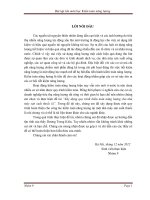Kiểm soát năng lượng tòa nhà
Bạn đang xem bản rút gọn của tài liệu. Xem và tải ngay bản đầy đủ của tài liệu tại đây (2.98 MB, 236 trang )
Building Energy Auditing
DEPARTMENT OF MINERALS AND ENERGY
DME-Danida Capacity Building in Energy Efficiency & Renewable Energy
Energy Assessment and
Savings Opportunity
Identification
Module 1: A Context for
Building Energy Audits
DEPARTMENT OF MINERALS AND ENERGY
DME-Danida Capacity Building in Energy Efficiency & Renewable Energy
Energy Efficiency in South
African Buildings
Module 2: Basic Principles of
Energy
DEPARTMENT OF MINERALS AND ENERGY
DME-Danida Capacity Building in Energy Efficiency & Renewable Energy
Understanding how energy
works in buildings
Learning objectives
DEPARTMENT of
MINERALS and ENERGY
Define energy in its various forms and energy
related properties;
Use the correct units for energy and power, and
convert from one unit to another as needed;
Determine the properties of steam and moist air;
Describe the mechanisms by which heat is
transferred;
Explain the effect of insulation on heat transfer,
and the means by which radiative heat transfer is
controlled.
DME Building Energy Audit Cours
e
4
Energy in its various
forms
DEPARTMENT of
MINERALS and ENERGY
Chemical – in fuels
Thermal – sensible
and latent
Mechanical
Electrical
Energy Equivalents
1000 joules (J)
1 kilojoule (kJ)
1 kilowatt-hour (kWh)
3,600,000 J or 3.6 MJ
DME Building Energy Audit Cours
e
5
Basic electricity
DEPARTMENT of
MINERALS and ENERGY
Voltage
This is what pushes electricity through a circuit the “driving force”
Units are Volts (V)
Current
This is what is pushed through by the voltage the “flow”
Units are Amperes (A) (“Amps”, for short)
DME Building Energy Audit Cours
e
6
Electrical power
DEPARTMENT of
MINERALS and ENERGY
When voltage and current work
together to do something useful - such
as turn a motor or light a lamp
Units are Watts
1000 Watts = 1 kilowatt (kW)
1 horsepower (HP) = 746 Watts
DME Building Energy Audit Cours
e
7
AC/DC
DEPARTMENT of
MINERALS and ENERGY
220 volts DC vs. time
310
220
220
220 volts RMS
0
0
-310
DME Building Energy Audit Cours
e
1/50 sec
8
Calculating power
DEPARTMENT of
MINERALS and ENERGY
Watts = Volts x Amps x Power
Factor
VA = Volts x Amps
Power factor (PF) indicates how well
the current
andLamps
voltage 100%
are working
Incandescent
together
Large Motors
80-90%
Small Motors
DME Building Energy Audit Cours
e
60-75%
9
Power Factor - lagging
current
310
310
220
220
0
0
-310
DEPARTMENT of
MINERALS and ENERGY
-310
DME Building Energy Audit Cours
e
10
Why should I care about
power factor?
DEPARTMENT of
MINERALS and ENERGY
Utilities may bill for Volts x Amps (kVA) or
apply a surcharge for PF below a set value
Note that kVA is always greater than or
equal to kW
Increased line currents
Low PF may suggest lightly loaded motors
Facilitates interpretation of electrical profiles
DME Building Energy Audit Cours
e
11
Power factor correction
DEPARTMENT of
MINERALS and ENERGY
Add capacitance
At service entrance
In distribution system
At point of use – e.g. on motors
DME Building Energy Audit Cours
e
12
Power and energy
DEPARTMENT of
MINERALS and ENERGY
Power = How Fast
(Demand)
Energy = How Much
(Consumption)
Energy = Power x Time
Units are kilowatt-hours (kWh)
DME Building Energy Audit Cours
e
13
What is efficiency?
DEPARTMENT of
MINERALS and ENERGY
Efficiency =Outpu
x
100%
t
Input
Device
Efficiency Input -
Output Heat
Electric
100% Elec - Heat
Incandescent Lamp10-20% Elec - Light
Motors
50-95% Elec - Power
Pumps/Fan
20-60% Elec - Flow
Air Compressor
5-15% Elec - Air
DME Building Energy Audit Cours
e
14
Thermal energy units
DEPARTMENT of
MINERALS and ENERGY
Unit of thermal energy is a Joule (J)
Typically use MJ or GJ.
1 Joule per second = 1 Watt
1 kWh = 3.6 MJ (0.0036 GJ)
1 boiler HP = 9,810 Watts
DME Building Energy Audit Cours
e
15
Other useful units
DEPARTMENT of
MINERALS and ENERGY
1 kWh = 3413 BTU
1 Ton of refrigeration
= 12,000 BTU/Hr
= 3.6 kW
DME Building Energy Audit Cours
e
16
Sensible and latent heat
DEPARTMENT of
MINERALS and ENERGY
100% Steam Quality
0% Steam Quality
Steam Only
100 C for Water at Sea Level
Water & Steam
0 C for Water
Ice
Sensible
Heat
Ice & W ater
Latent Heat
Heat Removed
Sensible
Heat
Latent Heat
Sensible
Heat
Heat Added
DME Building Energy Audit Cours
e
17
Humid air - psychrometry
DME Building Energy Audit Cours
e
DEPARTMENT of
MINERALS and ENERGY
18
“Quality” of heat - a question
of usefulness
The 100 litres will
be heated by
immersing its
container in one of
the larger
containers.
100 litres
@ 20 C
DEPARTMENT of
MINERALS and ENERGY
Required Temperature: 60 C
Required Energy: 16,800 kJ
Which will do the
job?
250 litres @ 100 C
84,000 kJ
1000 litres @ 40 C
84,000 kJ
DME Building Energy Audit Cours
e
19
Heat transfer
mechanisms
DEPARTMENT of
MINERALS and ENERGY
Radiation
Forced
Convection
Large Body @ 20 C
Small Body
@ 60 C
Air &
Surrounding
@ 20 C
Convection
Conduction
DME Building Energy Audit Cours
e
20









